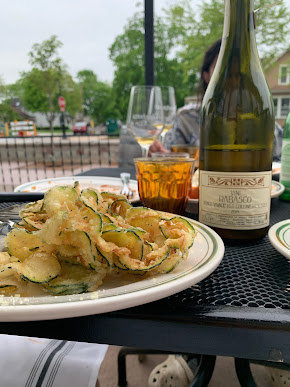There were about six months where, if you were at my house, you were drinking wine out of a cup made of clay. I had really just started serving wine at home to guests and the choice of vessel extended the feeling that I wanted them to have, cradled in a hand and soft. I also liked that your mouth was touching where someone's hand had made an impression, the fingerprints in the cup making clear the fingerprints in the wine. Or that was my idea, but in reality the glazed vessel does make the wine soft on your palate carrying more of the qualities of the finish on the cup than the wine itself so the switch to tasting glasses was made. This experiment in what is gained and what is lost in difference of vessel made me keen and always interested in others' experiences and cup preferences. My friend Riley and I have talked about this a lot, he liked to reminisce about drinking wine out of tumblers at Luce in Portland, where he used to live. He says in a tumbler the wine feels immediate and approachable. Every time I drink wine out of a glass like that I drink very fast.
This might be why last summer he asked me if I had heard of Vineria Il Passagio in Tokyo. When I told him I hadn’t he immediately sent me their Instagram full of bottle shots with shells and unglazed clay vessels positioned next to the wine. I couldn’t stop scrolling, trying to imagine drinking familiar wines out of unfamiliar vessels. The collection of pictures reminded me of some thoughts I’ve had but have been afraid to pursue but expressed with a confidence I still can’t summon. I’m working on it for myself, to write to you all about this, but for now I want to make sure you see a little bit about this wine bar.
I DMed the proprietor, Atsunori Satake, and asked if he would have the time to answer a few questions. He graciously offered his time to me and I’m so grateful. Out of respect to him I’ve kept it short and sweet on my end. I hope that his insights and ideas inspire your approach to your next glass of wine and perhaps the other things you touch/that touch you. Google translate provided my translation and Atsunori provided his own, I’ve included both the Japanese and English in our conversation.
How long has Vineria Il Passagio been open? Vineria Il Passagioはどのくらい開いていますか?
Vineria Il Passaggio has been open since 2013 ヴィネリア・イル・パッサッジョは2013にオープンしました。
Who are your mentors or who inspires your work most? あなたのメンターは誰ですか、それともあなたの仕事を最も刺激するのは誰ですか?
I have no mentor.The people who inspire my work are those who face their senses of all genres. For example, athletes, biologists, painters, potters, writers, physicists, philosophers, mathematicians, chemist, etc.
私にメンターはいません。私の仕事を刺激する人は、あらゆるジャンルの自らの感覚に向き合う人たちです。例えば、アスリート、生物学者、画家、陶芸家、作家、物理学者、数学者、化学者、などです。
Where do you find your vessels? 船はどこにありますか?
I'm looking for a vessel in Japan. My favorite potter is Yukiharu Kumagai, a earthenware potter.
器は日本国内から探しています。好きな作家は、土器作家の熊谷幸治です。
Will you explain your philosophy of pairing wine and vessel? ワインと器を組み合わせるというあなたの哲学を説明していただけますか?
e philosophy of combining wine and vessels starts with the idea that “I am in the position of wine."
The traditional method of serving wine has been "how people can enjoy wine". My philosophy is “how wine can enjoy”.
If there is a correct answer to the taste of wine, I feel that it is there.
ワインと器を組み合わせるという哲学は、「自分がワインの立場になる」ことからスタートしました。
これまで行われてきたワイン提供の方法は、「人々がワインをどのように楽しむことが出来るか」でした。私の考え方は、「ワインがどのように楽しむことができるか」です。もしワインの味わいの正解があるならば、そこにあるような気がしています。
This old post really spoke to me, will you talk about your idea behind it? この古い投稿は本当に私に話しました、あなたはその背後にあるあなたの考えについて話しますか?
My idea behind this post is about the importance of tactile sensation.
Specifically, the sense of touch also has sight, hearing, smell, and taste. Therefore, I think that when we drink wine, we also taste it tactilely.
In my experience, drinking wine with vinyl gloves blocking the sense of touch makes it taste bad. The taste goes far.
この投稿の背後にある私の考えは、触覚の重要性についてです。具体的には、触覚には視覚、聴覚、嗅覚、味覚もあるということです。よって、私たちはワインを味わうとき、触覚でも味わっていると、私は考えています。私の経験では、ビニール手袋で触覚を遮断してワインを飲むと、味わいが悪くなります。味わいが遠くに行ってしまいます。
What inspires your drawings and when do you draw? 何があなたの絵に影響を与え、いつ描きますか?
I draw whenever i want. I've never been inspired by anyone.
I don't mind if it’s not good.I try to draw my own feelings without lying or deception. I think that will lead to my growth.
絵はいつでも好きな時に描きます。誰かに刺激を受けたことはありません。下手でも良いから、嘘や誤魔化しがない自分の感覚を描こうとしています。そのことが自分の成長につながると考えます。
How has your project changed over time? あなたのプロジェクトは時間とともにどのように変化しましたか?
First of all, when I started Vineria Il Passaggio, I was using a regular wine glass.
Two years later, I take various glasses to better serve the wine.
The glasses used at that time were Zalt glass(Austria),Radikon glass(Slovenia ),Gravner glass(Italy),Baccarat glass(France),etc.
A year later, I started to feel something wrong when drinking natural wine in a wine glass.
Just then, I met a pottery cup.
I bought that cup, and put some natural wine in it and drank.
In that taste, something wrong I felt disappeared. And next I tried using a pottery cup without glaze. Its taste made a great impression on me. For wine, I feel that a vessels can be likened to a microscope to see the landscape of its taste. I felt that the landscape of wine was in focus by ungraded cup.
I started letting go of the wine glass the next day.
the next three years, I found a lot of vessels and studied their compatibility with wine every day.
Now I mainly use earthenware and shells. Studying will continue in the future.
まず、私がヴィネリア・イル・パッサッジョをスタートした時、私は一般的なワイングラスを使っていました。当時使用していたグラスは、ザルトグラス(オーストリア)、ラディコングラス(スロヴェニア)、グラヴネルグラス(イタリア)、バカラグラス(フランス)などです。
それから一年後、ナチュラルワインをワイングラスで飲む時に違和感を感じはじめました。
ちょうどその時に、陶器のカップに出会いました。そのカップを買い、ワインを入れて飲んでみました。その味わいからは、私が感じていた違和感が感じられなくなっていました。そして次に、釉薬のない陶器のカップも使ってみました。
その味わいは私に大きな印象を与えました。ワインにとって器は、その味わいの風景を見るための顕微鏡に例えることができると私は感じます。釉薬なしの器によって、ワインの風景にピントが合ったと感じました。そして私は翌日からワイングラスを手放しはじめました。そしてそれからの3年間で、器をたくさん見つけてワインとの相性を毎日研究しました。今は土器と貝殻を主に使っています。これからも研究は続きます。
There will maybe be some new wines later this week which we're looking forward to. DM or email us to talk about which wines do well out of plastic cups at a picnic or to get ahead of the new stuff. We always enjoy talking to you. Cheers:)
-Emily















